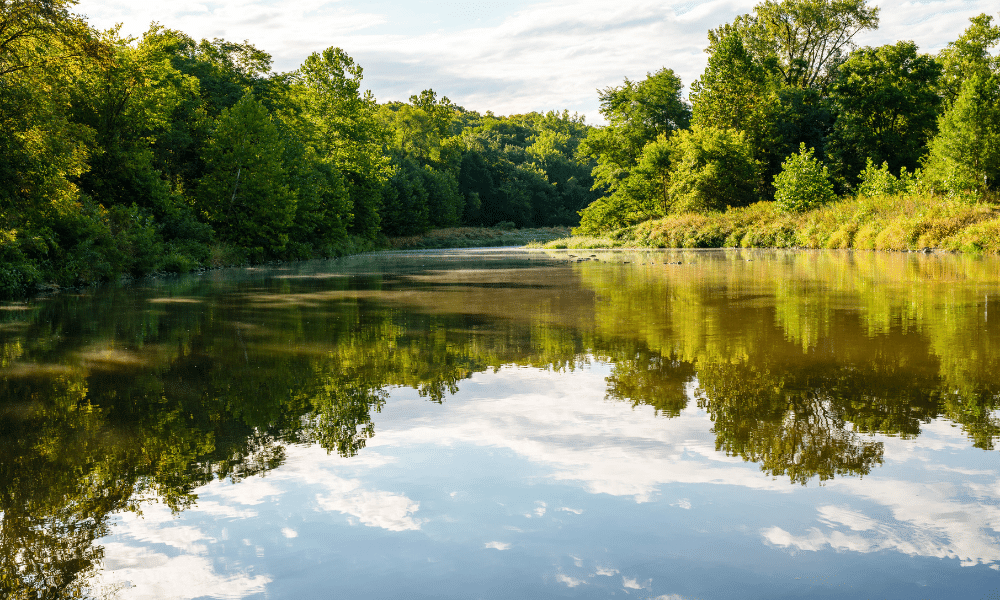
Edge of field conservation practices like bioreactors and satura ted buffers have proven to remove significant amounts of nitrates leaving fields. ISA is recognized as an organization helping farmers address water quality issues in the state. (Joseph L. Murphy/Iowa Soybean Review)
Leading the way in water quality
October 12, 2020
There may not be an “I” in team, but soybean farmers who are making strides in water quality know there is an “I” in collaboration.
Iowa Soybean Association (ISA) was recognized for this collaboration by receiving a 2020 U.S. Water Prize. It was presented earlier this year by the U.S. Water Alliance, an organization that promotes awareness of all areas of water management including business, manufacturing, agriculture and municipalities.
The alliance encourages the One Water concept – a holistic way of thinking about water as a resource that connects everyone.
Awarding seven prestigious prizes each year for those displaying exemplary efforts toward water stewardship, the U.S. Water Alliance selected ISA as the non-profit winner.
“We really weren’t expecting this,” says Roger Wolf, ISA director of innovation and integrated solutions, for ISA’s Research Center for Farming Innovation. “But it shows that ISA is recognized as an organization helping farmers address water quality issues on their farms and within their communities.”
Wolf says ISA’s “watershed approach” is what makes the organization stand out. Wolf and the team within ISA’s Research Center for Farming Innovation bring science and data to the forefront through agronomy research, data analytics and water monitoring.
“Mix all those pieces together and it’s really helping farmers embrace how changes on their farm are good for them in terms of production and also for folks downstream and throughout their watershed,” says Wolf.
Water monitoring plays a critical role in how ISA targets specific watershed areas. Samples are collected and tested for nutrients using an accredited water quality testing lab. ISA hosts one of the only labs in Iowa certified by the Department of Natural Resources with authority from the Environmental Protection Agency.
Tony Seeman, an ISA water quality scientist, says the lab was born from the desire to increase sampling. When the new ISA office was constructed in 2010, the lab became ready-to-use one year later.
“Our primary goal with the lab is to run water samples, and evaluate and put resources toward the areas with the biggest issues,” says Seeman.
A large part of Seeman’s time is in the field, working with partners on watershed projects. And when Seeman is not in the field, he’s in the lab recording data from samples collected from around Iowa.
“Everyone thinks they have the answers, but without data, you don’t,” Seeman Seeman says. “I always tell farmers, ‘you can’t manage what you don’t measure.’”
ISA’s lab measures for nitrates, phosphate, chloride and sulfates. It’s also certified to test for fluoride and E.coli bacteria. The lab can detect these pollutants and compute results in about one day.
Water sampling also offers farmers concrete proof that conservation efforts like cover crops and reduced tillage make an impact. And for farmers within project areas, such as the Middle Cedar Partnership Project and the Raccoon and Boone River watersheds, lab results show how they stack up against their neighbors in terms of the quality of the water leaving their land.
“A lot of it is education and engagement,” Seeman says. “We need farmers who are engaged and want to make an impact on improving water quality.”
Part of an integrated approach, Seeman says, water sampling is giving producers a look at what’s leaving their fields. This information helps them discover if they’re losing excess nutrients. Improving water quality is one of many goals, along with increasing yields and improving profitability.
For Wolf, the U.S. Water Prize is evidence that working together with landowners, farmers and partners while sticking to an integrated approach leads to real results.
“ISA is in a rare space within the One Water realm,” Wolf says. “We are out there engaging with farmers in a way they can benefit from and trust. Working collaboratively helps us approach the topic of water quality holistically. We aren’t in the business of just flag waving.”
The U.S. Water Alliance says collaboration is a primary reason ISA was recognized. Citing ISA’s ability to work with both agricultural and urban stakeholders, the alliance says this collaborative mentality is at the core of the One Water concept and cleaner water.
Wolf considers the future and how ISA, soybean farmers and partners can increase the number of conservation practices across Iowa’s landscape, even during turbulent years.
The next 20 years promise continued attention on water quality and agriculture’s role within it, Wolf predicts. Iowa’s large number of rivers, lakes and excess waters have many cities calling for a push in tourism. More people using Iowa’s waterways means increaed attention or how natural resources are being managed.
“We have a lot of work left to do, and the next generation is figuring it out,” Wolf says. “We’re not there yet.”
This story was originally published in the October 2020 issue of the Iowa Soybean Review.
Back